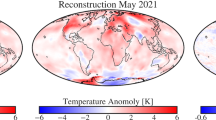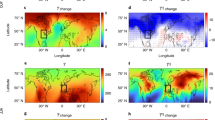Abstract
An approach to the calculation and display of second order space-time difference statistics, suitable for various applications ranging from weather forecasting to climate simulation, is discussed. The representation of the space-time agreement between model and observed quantities (or generally between any two data sets) depends on treating deterministic and random components of the variance in an appropriate way depending on context. A diagram to display the second order mean square difference, the correlation, and the ratio of variances on a single diagram in an intuitive way is also proposed. An example, comparing observed and simulated surface air temperatures from a group of models in the Coupled Model Intercomparison Program (CMIP), is presented.
Similar content being viewed by others
Author information
Authors and Affiliations
Additional information
Received: 26 January 2000 / Accepted: 9 June 2000
Rights and permissions
About this article
Cite this article
Boer, G., Lambert, S. Second-order space-time climate difference statistics. Climate Dynamics 17, 213–218 (2001). https://doi.org/10.1007/PL00013735
Issue Date:
DOI: https://doi.org/10.1007/PL00013735




